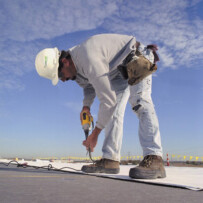
In our last blog post, we lamented the fact that meteorologists are predicting an early return to winter weather across large portions of the country. That means another tough season for wear-and-tear on commercial buildings – and an opportunity for roofing professionals to help facility managers plan ahead now. A close-up inspection of the roof can keep today’s small punctures, damaged flashings or torn seams from turning into tomorrow’s growing leaks, rising energy bills or spreading mold. Professional roofing contractors are intimately familiar with system specifications, installation, and how a finished system should look and perform. But even the most seasoned technician may not catch every potential problem.
A shocking development: “Thermal shock” is a leading cause of roof failure. As the seasons change, thermal conditions cause roofing materials to expand and contract – the “shock” happens when the stress of the expansion and contraction exceeds the strength of the material, causing a crack or split to form. In roofing, the effect is exaggerated because of different materials – i.e. the membrane, insulation and deck – expanding at different rates. GenFlex roofing membrane is engineered to maintain elasticity, flexing to resist the thermal cycles that come with the changing seasons. But all roofing materials become less flexible over time, and small splits can turn into big problems as they widen over the course of a rough winter.
Don’t just rely on your eyes: The ‘hairline cracks’ caused by phenomenon like thermal shock may be nearly undetectable. So with an older roof and the expectation of harsh winter weather, more sensitive equipment can be used to find the early stages of moisture infiltration below the roofing membrane:
- An electric capacitance meter provides an easy, affordable leak-detection tool – it transmits low-frequency signals through the membrane that identify elevated moisture levels. It’s important to note that the meter doesn’t identify the leak itself, only the resulting area of moisture; however, this will guide a trained contractor in finding the source. (Even if the moisture isn’t ultimately attributable to a roof leak, it’s still important to address it – moisture may cause mold growth or compromise the R-value of roof insulation, regardless of its origin.)
- Infrared cameras can also provide contractors with a color-coded ‘map’ of moisture under the roof surface, with a graphic display of temperature variations. However, interpreting the results requires experience, and users should be mindful of the time of day, outdoor temperature and the condition of the roof surface to produce consistent – and reliable – evidence of moisture.
Investigate the moisture: Identifying moisture infiltration is step one – after informing the building manager, remove a section of membrane to confirm and determine the extent of the issue. Moisture under the roof surface can lead to mold growth, and wet insulation means compromised thermal protection – robbing the building of its energy efficiency. Even where an unbreached vapor barrier is present, moisture or condensation within the roofing system must be addressed.
Standing up to damage, and behind its systems: GenFlex Roofing Systems mobilizes its national network of authorized contractors to repair or replace roofing if necessary, connecting with building owners within a day according to the system warranty. GenFlex contractors can play a valuable role in streamlining this process, while also being qualified to inspect other systems that may be more susceptible to wear and damage. In short, a comprehensive roof inspection for a commercial facility is much more than a quick scan and a checked box – especially when winter storms lurk right around the corner. Done properly, pre-winter inspection and repairs demand the skills of a roofing professional – a value-added opportunity for the proactive contractor.
For more information on GenFlex products and programs, visit www.GenFlex.com – to request training on product-specific installation and maintenance practices, click here.
